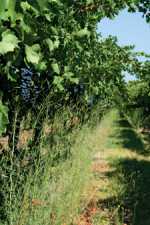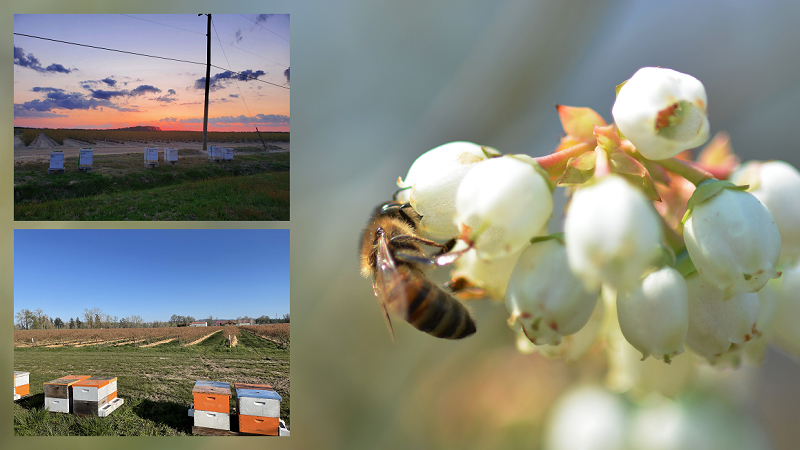Herbicide Alternatives Not A Silver Bullet In Vineyards

Willow herb, a weed common to California’s North Coast that is not controlled by glyphosate — though many growers futilely try — can actually grow up into grape clusters. Winegrape growers have unique weed concerns. With tree crops you won’t have weeds growing into the fruit. On the bright side, you don’t have to keep a vineyard floor clean like nut growers must do.
As most longtime winegrape growers can tell you, weed problems have changed drastically through the years. Perhaps the top reason is that the “once-in-a-lifetime” herbicide, as weed expert John Roncoroni terms glyphosate, has worked almost too well.
When it went off-brand and became relatively inexpensive, it was overused in recent years to the point that many common weeds are showing resistance. In addition, many weeds that at one time were considered minor have become important because they are not controlled by glyphosate.
In California’s San Joaquin Valley, hairy fleabane and especially horseweed have shown resistance to glyphosate. In the northern Sacramento Valley, annual ryegrass has developed resistance. In the North Coast region, where Roncoroni serves as University of California farm advisor in Napa County, three weeds have proved to be tolerant to glyphosate: fillaree, malva (cheeseweed) and, especially, willow herb.
It doesn’t have to be this way, says Roncoroni. With insect and pathogen control, growers are familiar with the concept of avoiding resistance by using another approach: Break the cycle. “My recommendation to all growers is break the cycle (of weed growth). I don’t care how you do it, but break the cycle,” he says. “I’m not going to get them to stop using glyphosate because it’s not only cheap, but it’s safe and very effective. But it’s not effective on all weeds, and you’re going to have to try something else.”
The main approaches Roncoroni recommends exploring are cultivation, the use of alternative herbicides, and cover crops. Other approaches that can work in certain situations include bringing in sheep and putting down mulch. Here’s a brief look at each.
Cultivation — This traditional method works great, but growers have gotten away from it because of the high cost of labor and to avoid erosion problems. Much of the Napa Valley used to be tilled with the use of an under-vine french plow, but erosion concerns, especially silt in creeks affecting fish, has greatly reduced the practice.
In recent years, with all the talk of sustainability, a lot of growers have gone to no-till or minimum till. That’s fine, but Roncoroni believes that a cultivation every three years or so is reasonable. “Cultivation is fairly expensive,” he says, “but what I say to the grower is ‘Pay me now or pay me later.”
Alternative Herbicides — This is the least expensive way to go, and there are a lot of herbicides registered, far more than most growers think. For example, people have successfully used Goal (oxyfluorfen, Dow AgroSciences) for years, which works well on stubborn weeds like willow herb.
Pre-emergent herbicides are considered by some to be something to avoid because they can get into the water, but Roncoroni says if used carefully, many are very safe. For example, hitting willow herb when young with gluphosinate can work. It’s a lot better than treating it with glyphosate, which in Napa especially has proven ineffective.
Cover Crops — When you have grass growing, an early maturing grass under vines, it competes with weeds. You can mow this grass, and use it to out-compete weeds, especially aggressive, broad leaf weeds like willow herb. Try an annual grass like a fescue that dies out fairly early so it won’t compete with the vines for water. “You have something that you know what it is that you can control, as opposed to weeds that you can’t control,” he says.
Mulch — This can provide excellent control, but it can be very expensive, both to purchase and to put it down. If everything works and it lasts five years or more, and you can amortize costs, that’s great. “But I did some calculating for a grower who thought he solved (his weed problem), and he would have needed 20 miles of mulch,” says Roncoroni. Mulch has also been known to harbor pests, such as gophers. “It’s like building them a protective screen,” he says.
Sheep — They can be effective, but you need to have a lot of sheep at a high density to do any good, and you need to get them out before bud break. Also, you can’t put them in when the ground is wet because compaction can really be a concern.









